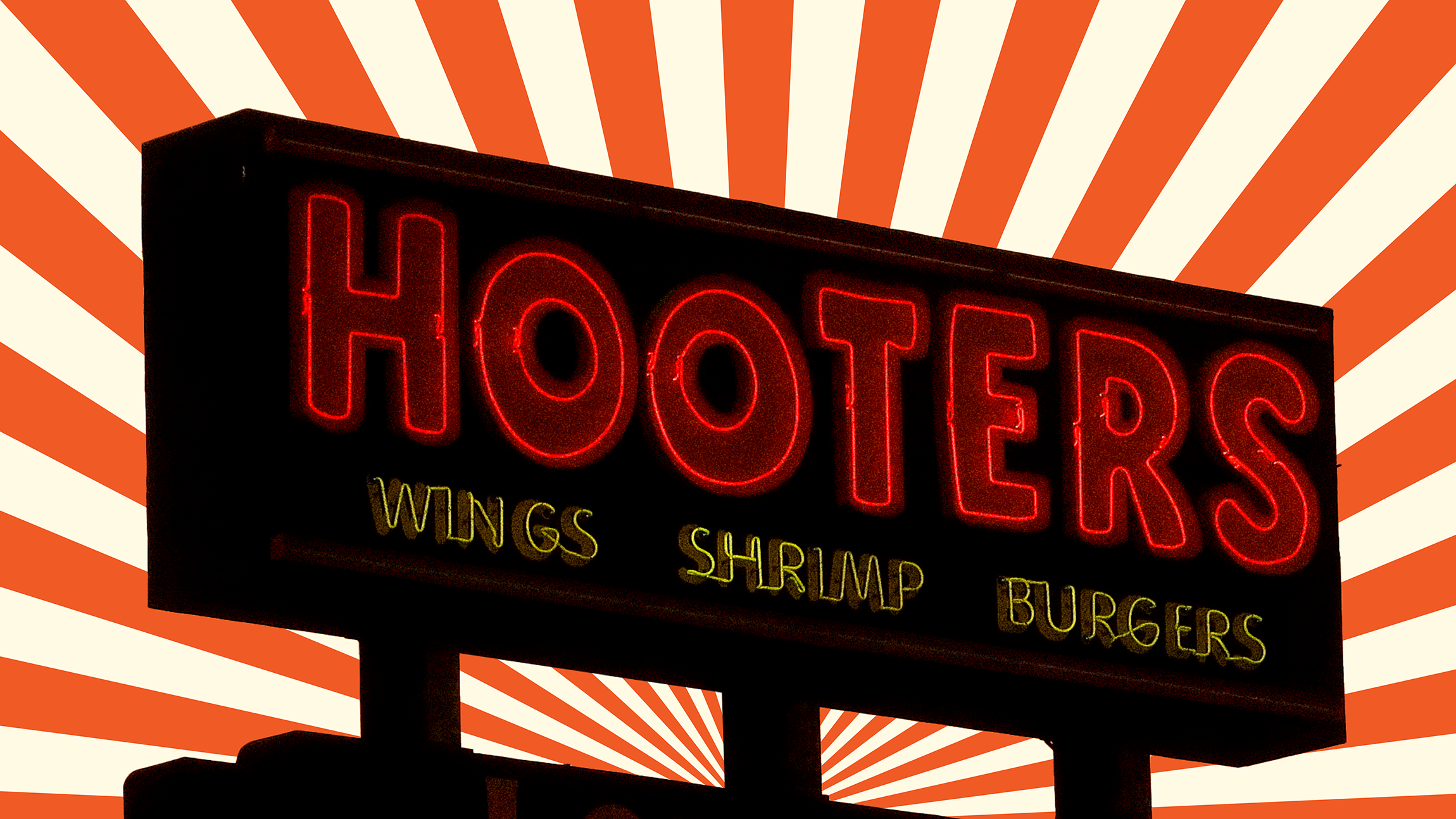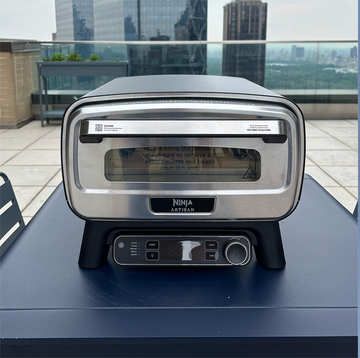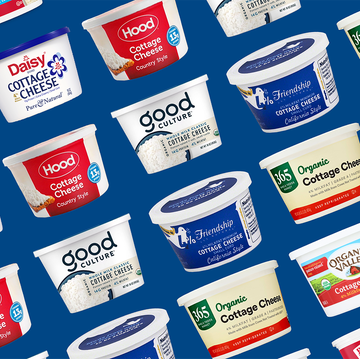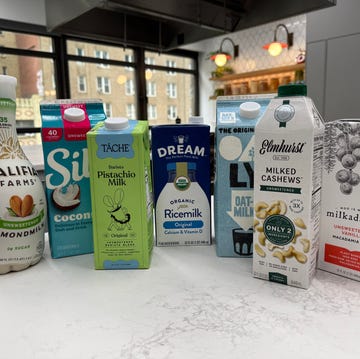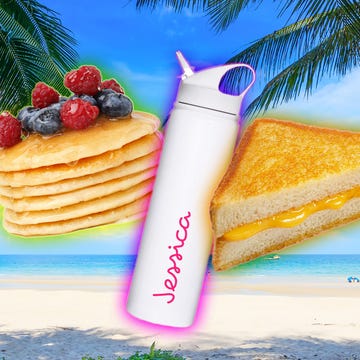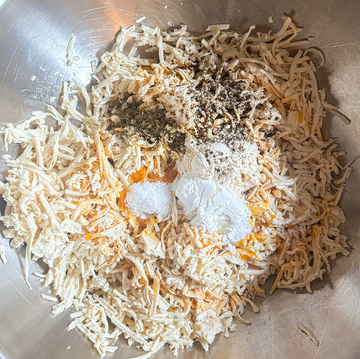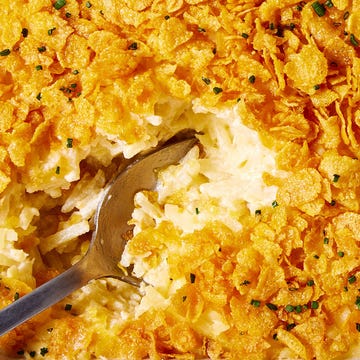My first and most lasting memory of Hooters comes from the movie Big Daddy. The chain is a running joke throughout the Adam Sandler film, where it’s framed as a deep embarrassment for a woman to have worked there, even if she has a better career now. The final gag of the movie is learning that the evil ex-girlfriend now works there, too—a fitting punishment for having wronged the main character.
It’s all sexist and juvenile and very 1999, which may be why it’s not so surprising to hear that, a quarter century and light years of cultural shifts later, Hooters is having some financial difficulties. Earlier this year, the company filed for Chapter 11 bankruptcy protection.
The last few years have been tough on seemingly every nationwide mall brand you can think of, whether a retailer (Macy’s, JCPenney, Kmart, Big Lots, Bed Bath and Beyond, Party City) or food joint (TGIFriday’s, Red Lobster, Applebee’s, Denny’s). Through it all, Hooters has kept chugging along, opening locations in more promising markets, offering new promotions, and expanding its footprint overseas. How has the brand managed to survive? And do they possibly have another few decades left in the keg?
Hooters was incorporated on April Fools’ Day, 1983, by six businessmen and friends with no prior experience in the food industry. The company jokes that this day was "appropriate" given the tongue-in-cheek branding and the opening team’s lack of experience.
In October of the same year, the first restaurant opened off a highway in the beach town of Clearwater, Florida. By 1984, there was a two-hour wait to get a table.
All of the brand’s most indelible elements were there from the beginning: the traffic-cone orange color, the owl logo, the double entendres (at one point, the original double Os in the name looked even more like breasts), the waitresses in tiny shorts, and the chicken wings. Toward the end of 1984, the six friends sold the expansion and licensing rights to businessman Hugh Connerty, who expanded to Tampa, Lakeland, and Atlanta as Neighborhood Restaurants, which eventually became Hooters of America. Another investor and food entrepreneur, Robert H. Brooks, later bought him out and eventually gained majority control and chairmanship of the company. With these experts on board, Hooters exploded.
The success was about more than financial acumen. The mid-1980s were a golden era of hot-girl culture. Months after two models ripped their clothes off in front of grade-school students in Van Halen’s "Hot for Teacher" video, Hooters introduced its debut calendar of Hooters girls. A main draw was a blonde girl-next-door, Lynne Austin, a server from Florida whom one of the original founders had recruited from a Clearwater bikini contest. She appeared in Playboy in 1986, touting an association with the owl-faced brand, and in 1987, she and other Hooters girls started appearing on TV.
The "Hooters girl" was a national phenomenon and icon of the era, but that branding didn’t end with the 1980s. Hooters' jarred wing sauces hit grocery store shelves in 1993, and the decade brought NASCAR sponsorships, which led to the Hooters Cup Racing Series and additional sports involvement, like a golf tour and an arena football team called the Miami Hooters. The Miss Hooters International Swimsuit Pageant launched in 1997. The business development carried right into the 21st century, with Hooters Air launching in 2003 and Hooters Casino opening near the Las Vegas Strip in 2006. Both ventures lasted longer than you’d think, at three and 13 years, respectively.
In another clear sign of success, other "breastaurant" chains sprang up at the same time, such as the Texas-based Twin Peaks in 2005, which featured a breast-inspired logo and waitresses in revealing red-plaid tops; the Texas-based Bikinis Sports Bar & Grill in 2006, where the waitresses wore straight-up bikini tops while serving; and the Texas-based (see a theme?) Ojos Locos, launched with one of the Twin Peaks founders in 2010, which targets a Latino market and calls its servers "chicas."
Of course, the company had its fair share of legal controversies, usually around gender discrimination at the corporate level and sexual or racial harassment at individual franchises. In 1997, three Illinois men sued the company for only hiring female waitresses, to which the company argued that the staff were entertainers and that their sex was a Bona Fide Occupational Qualification, an exception to Title VII of the Civil Rights Act. They received a small settlement each, and four men in Maryland who’d filed a similar suit got pay days, too. At least twice in the 2010s, Hooters girls sued after their managers criticized their physical appearances during job performance discussions.
Still—still!—Hooters held on right through the 2010s, peaking at 452 locations worldwide. On its 40th anniversary in 2023, the company boasted about its focus on international development, having just opened the world’s largest Hooters in Liverpool, England, with over 300 seats.
But months later, in the summer of 2024, the company shut down over 40 "underperforming" locations, with 16 closing in Texas alone. That exact same month, Hooters launched branded chicken wings and popcorn chicken at Publix supermarkets.
On March 31, 2025, Hooters of America, Inc. announced its filing for Chapter 11 bankruptcy protection. The company had "gone bust," as the Associated Press punned.
Declaring bankruptcy is not the end of a company, though, not when it’s under Chapter 11 of the Internal Revenue Code. "Chapter 7 means we’re going to shut the entire operation down today and sell everything off; there’s no hope left for this business. Chapter 11 gives a company time to reorganize itself while remaining in operations," says Arthur Dong, a professor at Georgetown University’s McDonough School of Business, "meaning a company such as Hooters can immediately stop payment to all of its suppliers and landlords while [restructuring] is undertaken."
Put another way, "Bankruptcy is a tool. It's not a tombstone," says Stephen Zagor, a longtime restaurant consultant and professor at Columbia Business School, which explains why Hooters can launch new licensed products, open franchises abroad, and plan for development in the U.S. at the same time. "It doesn't mean that they can't expand into new locations, and maybe even morph the concept into a more up-to-date version."
It sounds like that’s exactly the company’s plan. Within days of the filing, Hooters of America CEO Sal Melilli announced some proposed changes, including higher-quality ingredients, the end of weekly bikini nights, and a stronger emphasis on franchises getting involved in their local communities, charities, and causes.
Interested in hearing more about the food itself (as well as everything else the company has planned), Delish spoke with Melilli, whose Zoom background was, naturally, the inside of a Hooters restaurant. "We do have fresh wings, never frozen. Our sauce is made with butter, and that butter is a unique ingredient. It's decadent, it's indulgent. We're the only place that has breaded chicken wings," he says. "So to have all of our franchisees having the same product—to have that butter-based sauce—is a super cool, key component for the consumer to return to what made Hooters as successful as it was all these years." Many locations, he added, will be remodeled and updated for a better overall dining experience.
Melilli admitted that business looked pretty great after the pandemic, but that didn’t last long. "People had a lot of reserved cash, so they felt very comfortable as they got back into society. [But] just as fast as that optimism came out of Covid, so did inflation," he says. "Dining out became a luxury, and I think the consumer became highly selective as to how they were going to spend their dollars."
It’s not going to get easier for fast-casual restaurants in the U.S. any time soon, Dong estimates. "The industry is confronting a double whammy. One, these increased food costs have been sticky: They’ve gone up, and they haven’t receded. Two is labor costs," he says. "Now that the pandemic is over and those government subsidies disappeared, these businesses are finding that a lot of former waitstaff and employees are not coming back, with higher labor costs and labor scarcity as a result." Economic uncertainty caused by recent tariffs is unlikely to help the sector, either.
Internationally, the brand remains a notable success story, albeit one that is somewhat cognitively dissonant. Take the Hooters overlooking the Alps in Interlaken, Switzerland, the one located near a botanical garden outside Johannesburg, South Africa, or the spot giving killer views of Taipei 101 in Taiwan. "It’s a piece of Americana, right? People know Hooters. It resonates," Melilli ventures. "I think people have great comfort knowing what they're getting around the globe."
"It’s not just nostalgia, but novelty. They are, in a sense, a representation of American culture," Dong adds. "Maybe part of the reason why Hooters is not doing very well in the United States is because it's a little misogynistic; it's like a jiggle joint."
Many of the offspring breastaurants like Twin Peaks and Ojos Locos are hanging in there across the southern U.S., too. These businesses, and Hooters' restructuring, exist now in an interesting cultural moment, when some customers absolutely yearn for and delight in a non-PC, unwoke, throwback brand. "Hooters is a fun concept! I mean, it obviously started with a sexual undertone of attractive women serving spicy chicken wings," Zagor says. "Concepts have to evolve with changing markets. What was exciting and titillating and what made Hooters special in the past is not what’s going to make it special in the future."
Certainly, it seems that Melilli wants the company to be remembered for more than booty shorts and being the butt of a joke. "We’ve always been a neighborhood restaurant. We say we’re the escape from the rigors of everyday life. You get promoted? Hey, go to Hooters to celebrate. You lost your job? In bad times, you still go to Hooters," he says. "When you go into a typical Hooters during the day, you see a really good cross-section of America."
And the girls? They aren’t going anywhere. "We have alumni of over 500,000 Hooters Girls who have worn the orange shorts and gone on to unbelievable careers," Melilli says, citing examples like doctors, oil-rig owners, and celebrities such as Amy Adams, Chrissy Teigen, and the Bella twins. "When we talk about a family environment and say our folks bleed orange, that's the legacy."
Weeks after Delish spoke with Melilli, another 30 Hooters locations closed across the U.S., in states including Michigan, Florida, Georgia, Tennessee, and Texas. It’s all pretty depressing, the kind of situation that makes you want a cold beer. The proclaimed updates sound decent—who doesn’t love butter and charity?—but can Hooters truly adapt while holding onto those tiny orange shorts? Or is that branding exactly what will make a new generation of customers flock?
Timeline:
1983 - Courtesy Of Hooters
1985 - Courtesy Of Hooters
1991 - Courtesy Of Hooters
1997 - Ethan Miller/Getty Images
2003 - Erik S. Lesser/Getty Images
2006 - Ethan Miller/Getty Images
2024 - MediaNews Group/Reading Eagle/Getty Images
2025 - MediaNews Group/Reading Eagle/Getty Images
Buffalo Wings - Courtesy Of Hooters, Opening Team - Courtesy Of Hooters, Curly Fries - Courtesy Of Hooters, Alan Kulwicki - Courtesy Of Hooters, Lynne Austin - Courtesy Of Hooters, Lots-A-Tots - Courtesy Of Hooters, Closed Hooters - MediaNews Group/Reading Eagle/Getty Images, Chocolate Cake - Courtesy Of Hooters, Hooters Server & Kids - Courtesy Of Hooters
Art Direction: Carlos Dominguez, Design: Alison Dominguez, Photo Direction: Rebecca Simpson Steele, Photo Research: Cindy Roblero, Animations: Vineet Sawant
